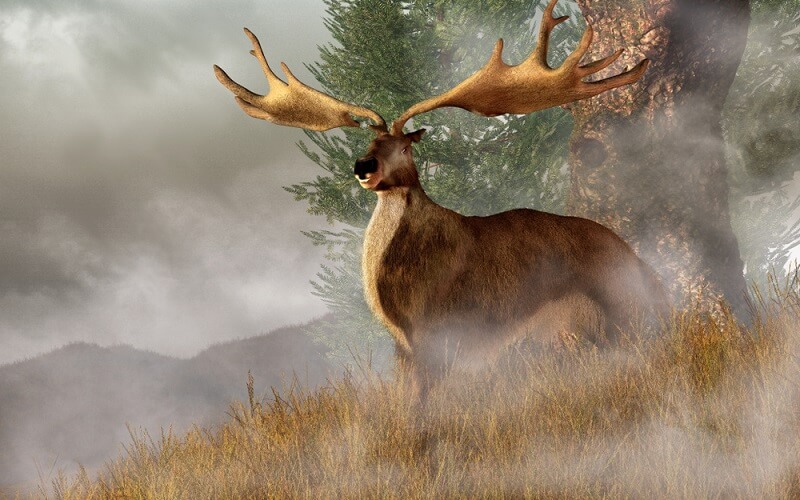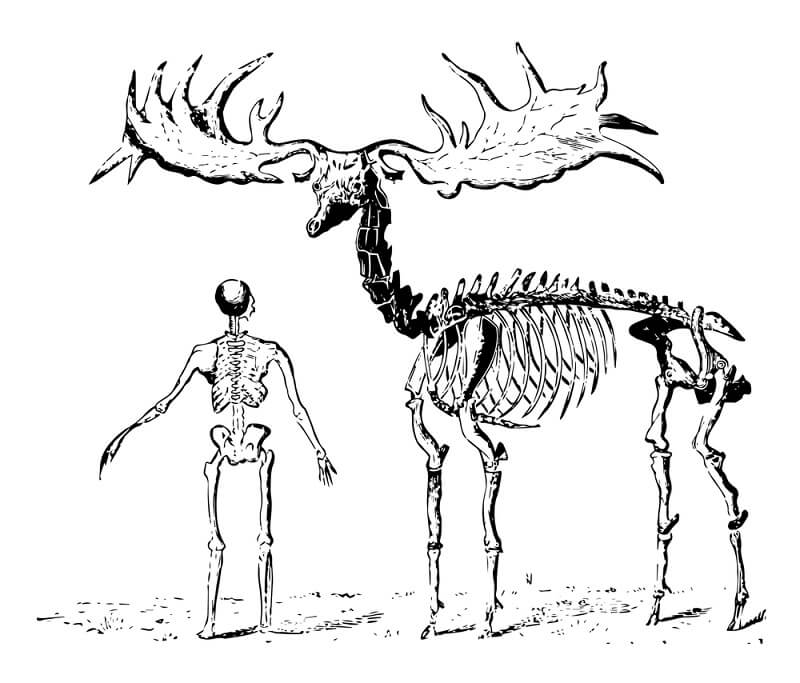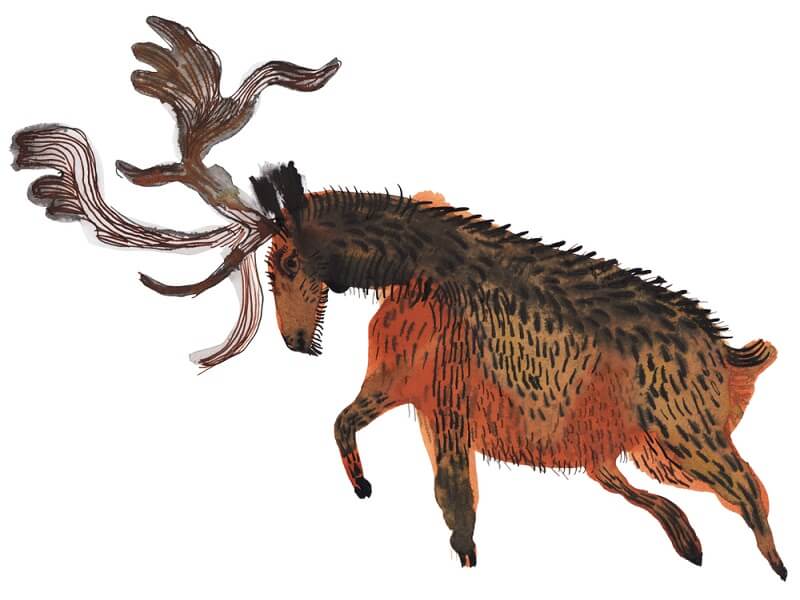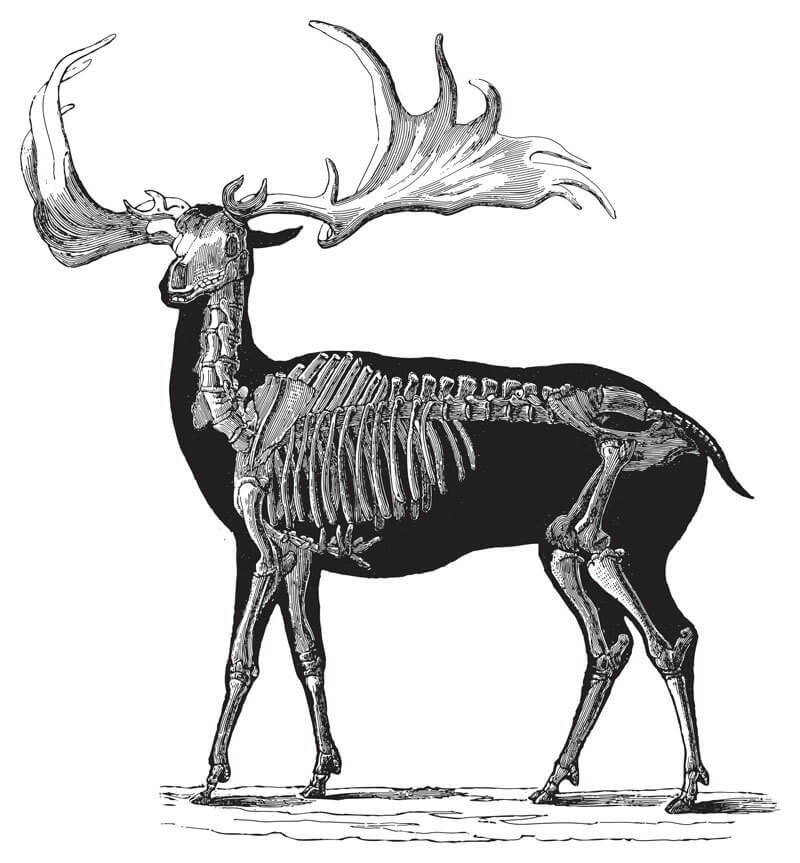
| Kingdom | Animalia |
| Phylum | Chordata |
| Class | Mammalia |
| Order | Artiodactyla |
| Family | Cervidae |
| Genus | Megaloceros |
| Species | Megaloceros giganteus |
| Niche | Herding Herbivore |
| Height | Up to 7 feet (2.1 m) |
| Weight | 1,200-1,500 lbs (540-700 kg) |
| Lifespan | Unknown |
| Social Structure | Unknown, though likely similar to deer |
| Conservation Status | Extinct (7,000 years ago) |
| Preferred Habitat | Grasslands |
| Average Number of Offspring | Unknown |
| Main Prey Species | Likely grasses, vegetation |
| Predators | Humans, likely extinct predators like the saber-toothed tiger |
The Basics
The Irish Elk is an extinct species within the Cervidae family – closely related to living deer species. Also known as the ‘giant deer’ and most closely related to the fallow deer, the Irish Elk is named mostly for its massive size. It is not as closely related to the European elk (moose) or the North American elk (wapiti). The species is known for its massive size, massive antlers, and slight hump on its front shoulders.
Though Irish Elk remains have been found all throughout Europe, the peat bogs of Ireland preserved many specimens that were well-intact. The scientific name – Megalocerus giganteus – refers both to the massive antlers (‘megalos’=great + ‘cerus’=antler) and the creature’s massive size (giganteus). Antlers from this species have been found that are nearly 12 feet (3.6 m) wide!

Like other deer species, the Irish elk was likely a herding species that centered around reproduction, with males competing directly for access to females. Their large antlers, some of the largest in the animal kingdom, were likely a sexually selected trait. Females prefer males with larger antlers – both because they can fight better and because larger antlers imply a greater fitness.
Why Did the Irish Elk go Extinct?
The youngest fossil Irish elk is only around 7,700 years old, uncovered in parts of Siberia. Though populations likely when extinct at different times in different parts of the globe, this seems to be the last time the Irish Elk was seen on Earth. Exactly why the Irish elk went extinct is still up for debate, though several theories abound.
Several drastic changes occurred over the face of the globe during the last few thousand years that Irish elk were widespread across Europe. The first was the Last Glacial Period – a time of generally lower temperatures and fully-developed glaciers that extended from around 115,000 years ago to around 11,700 years ago. After that time, glaciers melted away and global temperatures slowly began to rise. Not only did this change the types of vegetation available, but it also helped humans expand their population throughout Europe.
Several theories suggest that human hunting was the ultimate cause of Irish elk extinction, whether this was due to maladaptations of the elk – such as its massive antlers that could have prohibited running – or simply widespread hunting that constantly reduced the population until it went extinct. Humans have wiped out many of the largest animals across many continents, so this theory is highly likely.

Interesting Insights from the Irish Elk!
Just because the Irish elk is extinct does not mean it has nothing to teach us about biology. In fact, extinct animals often give us some of the greatest insights into evolution, the process of extinction, and several other biological concepts. Let’s look at a few of the most important concepts displayed by the Irish elk.
Extinction Detectives
Part of the job of a paleontologist is to piece together the lives of animals that no longer exist. To do so, they rely on every clue they can pull from the fossils that they find. In the case of the Irish elk, many fossils were well preserved in the Irish peat bogs and other places around the globe. Thus, paleontologists are able to make educated guesses as to how this species eventually went extinct.
For instance, by measuring the size of antlers over time, scientists have shown that the average size of antlers was actually decreasing at the time the massive deer went extinct. This suggests that the antlers were too large, and animals with smaller antlers were actually more successful at surviving and reproducing. Coupled with the fact that antlers and bones from the species have been found in ancient human settlements suggests that humans were very familiar with the species and likely used it as a source of food.
The Loss of Large Species
As humanity expanded over the globe at the end of the last Ice Age, they brought with them a heavy appetite for the large game animals present in these new regions. As such, many of these creatures were hunted to extinction long before modern civilization. The Irish elk is joined by many animals that were likely wiped out by early human settlements.
Also included in this group are the woolly mammoth, the mastodon, the American lion, ground sloths, the dire wolf, giant armadillos, saber-toothed tigers, and many more large species that thrived during the cold periods before the expansion of humanity. Many of these species were hunted to extinction for their meat, while some of the larger predators likely went extinct due to a lack of prey and persecution by early farmers and human settlements.

With extinctions continuing at a high rate to the modern-day, many scientists have suggested that humans are actually responsible for the Sixth Mass Extinction, an event that is ongoing and could end up wiping out a majority of the species on Earth. While the loss of one species is not necessarily a cause for concern, the loss of hundreds, thousands, or millions of species should be concerning.
These species make ecosystems function. Without them, entire ecosystems could collapse. While you can’t blame early humans for doing their best to survive, we now live in a world where eating meat is unnecessary for most people and we recognize that there are ways to develop human settlements sustainably in ways that do not impact the environment. There is no reason that we should still be driving many species to extinction.
